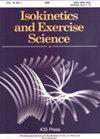Reliability and validity of hand-held dynamometry for assessing lower limb muscle strength
IF 0.6
4区 医学
Q4 ENGINEERING, BIOMEDICAL
引用次数: 0
Abstract
BACKGROUND: Hand-held dynamometry (HHD) is used to assess muscle strength in various patient populations, but many variations in protocols exist. OBJECTIVE: First, to systematically develop a protocol of HHD for all lower limb muscle groups and evaluate intra-rater reliability; second, to validate HHD with fixed dynamometry for the knee flexor and extensor muscles. METHODS: Thirty healthy young adults (women: men – 15:15) participated in two testing sessions. HHD of 12 lower limb muscle groups was performed in both sessions, while fixed dynamometry of knee muscle groups was performed only in the second session. RESULTS: The intra-rater reliability of HHD was good for five muscle groups and excellent for seven muscle groups (ICC3, k= 0.80–0.96). The criterion validity of HHD ranged from very good to excellent for the knee flexors (r= 0.77–0.89) and from good to very good for the knee extensors (r= 0.65–0.78). However, peak moment values for the knee extensor muscles were underestimated by 32% (p< 0.001). CONCLUSIONS: The proposed HHD protocol provides reliable and valid measurements of lower limb muscle isometric strength in healthy adults, which may also be used to test patients with mild muscle strength deficits. However, possible underestimation of absolute strength must be considered when interpreting the results of knee extensors or other large muscles.手持式测功仪评估下肢肌力的可靠性和有效性
背景:手持式测力仪(HHD)用于评估不同患者群体的肌肉力量,但方案存在许多差异。目的:首先,系统地制定适用于所有下肢肌肉群的HHD方案,并评估评分者内部的可靠性;其次,用膝屈肌和伸肌的固定测力法验证HHD。方法:30名健康的年轻人(女性:男性–15:15)参加了两次测试。在两个疗程中对12个下肢肌肉组进行了HHD,而仅在第二个疗程中进行了膝关节肌肉组的固定测力。结果:HHD的评分者内可靠性对5个肌肉组良好,对7个肌肉组极好(ICC3,k=0.80–0.96)。HHD的标准有效性对膝屈肌从非常好到极好(r=0.77–0.89),对膝伸肌从良好到非常好(r=0.65–0.78)。然而,膝伸肌的峰值力矩值被低估了32%(p<0.001)。结论:所提出的HHD方案为健康成年人的下肢肌肉等长力量提供了可靠有效的测量,也可用于测试轻度肌肉力量缺陷的患者。然而,在解释膝伸肌或其他大肌肉的结果时,必须考虑对绝对力量的可能低估。
本文章由计算机程序翻译,如有差异,请以英文原文为准。
求助全文
约1分钟内获得全文
求助全文
来源期刊

Isokinetics and Exercise Science
医学-工程:生物医学
CiteScore
1.20
自引率
14.30%
发文量
37
审稿时长
>12 weeks
期刊介绍:
Isokinetics and Exercise Science (IES) is an international journal devoted to the study of theoretical and applied aspects of human muscle performance. Since isokinetic dynamometry constitutes the major tool in this area, the journal takes a particular interest in exploring the considerable potential of this technology.
IES publishes studies associated with the methodology of muscle performance especially with respect to the issues of reproducibility and validity of testing, description of normal and pathological mechanical parameters which are derivable from muscle testing, applications in basic research topics such as motor learning paradigms and electromyography. The journal also publishes studies on applications in clinical settings and technical aspects of the various measurement systems employed in human muscle performance research.
The journal welcomes submissions in the form of research papers, reviews, case studies and technical reports from professionals in the fields of sports medicine, orthopaedic and neurological rehabilitation and exercise physiology.
 求助内容:
求助内容: 应助结果提醒方式:
应助结果提醒方式:


